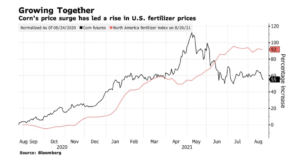Congress has quickly engaged in putting together potential aid packages for farmers that would more than double the Trump administration's $12 billion under the Farmer Bridge Assistance (FBA) Program.
Inflationary Pressures and Drought Jolt Farmers, While Unpredictable Grocery Supply Issues Persist
Earlier this week, Bloomberg writers Kim Chipman and Michael Hirtzer reported that, “Minnesota farmer Jason Knopik didn’t sell corn earlier this year as prices soared, missing out on one of the biggest rallies in a generation. Now he’s grappling with inflation.
“Knopik held back as lack of rain put the fate of his plants into question. His drought-stricken fields have seen less than 10 inches of rain since planting in May, almost 40% below normal, and it’s so arid the creeks on his land dried up that he’s had to truck water to his cows. Knopik’s corn and soybeans survived, but he’s now getting hit with soaring costs for fertilizer and propane on top of a nearly 30% jump in rent.”
The Bloomberg writers explained that,
A similar dilemma is happening across the U.S. corn belt with the profit potential for farmers appearing to have peaked, due to surging inflation that followed the biggest crop rally in almost a decade.
“The agricultural boom is starting to filter through supply chains, making items like meat, cereal and packaging more costly and cutting into margins for goods growers use to produce food that helps feed the world. The U.S. accounts for nearly a third of the world’s corn and soybean exports.”

“A gauge of North American fertilizer prices has nearly doubled in the last 12 months. The corn rally is seen as likely boosting per acre seed costs by $6 to $7 next year over 2021, according to University of Illinois economists. That compares to an annual average increase of $2.70 from 1975 to 2020,” the Bloomberg article said.
As producers cope with higher costs, the implications of ongoing drought for farmers continues to garner attention.
New York Times writer Henry Fountain reported on Wednesday that, “Darrell Rice stood in a field of corn he’d planted in early June, to be harvested in the fall and chopped up to feed the hundreds of cows and calves he raises in central North Dakota.
“‘It should be six, seven, eight foot tall,’ he said, looking down at the stunted plants at his feet, their normally floppy leaves rolled tight against their stalks to conserve water in the summer heat.
“Like ranchers across the state, Mr. Rice is suffering through an epic drought as bad or worse than anywhere else in this season of extreme weather in the Western half of the country.
A lack of snow last winter and almost no spring rain have created the driest conditions in generations. Ranchers are being forced to sell off portions of herds they have built up for years, often at fire-sale prices, to stay in business.
The Times article noted that, “North Dakotans have seen drought many times before. One in 1988 was particularly bad, although John Marshall and others who made it through that year said the current drought is worse.”
Also Wednesday, in a separate Times article, Adeel Hassan reported that, “A 53-foot waterfall near St. Paul, Minn., has been reduced to a trickle. Utah’s biggest reservoirs are about half full, and dropping. Almond growers in California are abandoning their dying trees as water grows increasingly scarce.
“Nearly half of the land mass of the contiguous United States — 47 percent — is experiencing drought conditions, according to the latest report from the U.S. Drought Monitor, and it’s getting worse in the Northern Plains and everywhere west of the Rocky Mountains.”
“The drought is even more dire in California, which produces one-third of the country’s supply of vegetables and two-thirds of its fruit. Nearly half of the state is in ‘exceptional’ drought, up from one-third of the state in July,” the Times article said.
Meanwhile, on the consumer end of the supply spectrum, Wall Street Journal writer Jaewon Kang reported earlier this week that, “Grocery-store chains are still battling supply challenges that some executives said are as bad as what they saw in spring 2020, when hoarding left holes in stocks of some staples.
“Industry executives say new problems are arising weekly, driven by shortages of labor and raw materials. Groceries including frozen waffles and beverages remain scarce as some food companies anticipate disruptions lasting into 2022. A wider range of products is running short and logistical challenges are compounding for many retailers.”
The Journal article stated that, “Many grocery chains said that it is hard to predict how complete or on-time their deliveries will be due to limited guidance from suppliers, and executives said there is often little recourse when trucks show up with a fraction of what was ordered. Demand is higher than expected by retailers, with monthly sales up about 14% from two years ago and 3% from a year ago, according to data from research firm IRI.”
Similarly, Bloomberg writers Leslie Patton and Deena Shanker reported on Tuesday that, “Some of the largest U.S. food distributors are reporting difficulties in fulfilling orders as a lack of workers weighs on the supply chain.
“Sysco Corp., North America’s largest wholesale food distributor, is turning away customers in some areas where demand is exceeding capacity. The company also said prices for key goods such as chicken, pork and paper products for takeout packaging are climbing amid tight supplies. In particular, production has slowed for high-demand, labor-intensive cuts like bacon, ribs, wings and tenders, Sysco said.”





